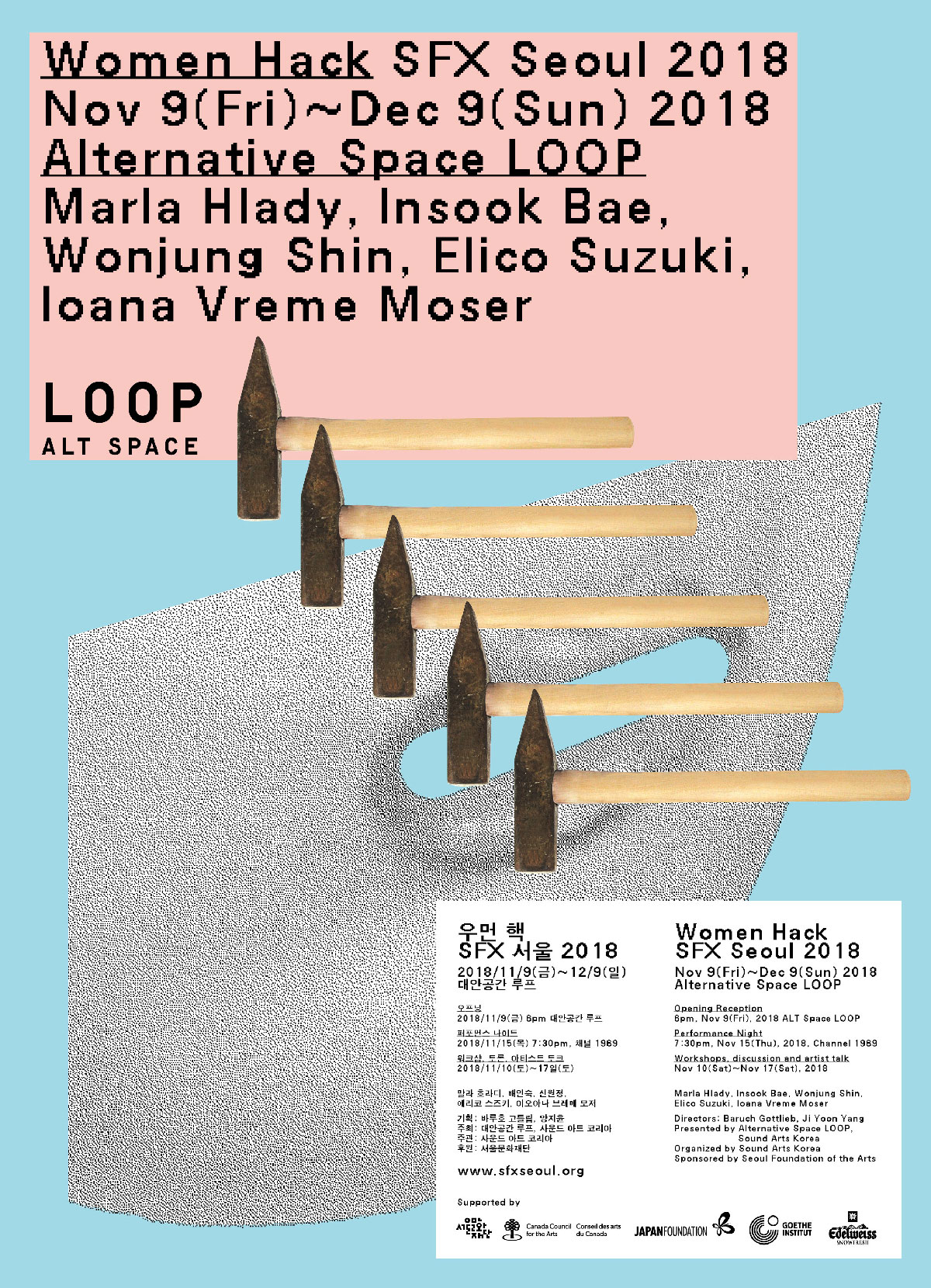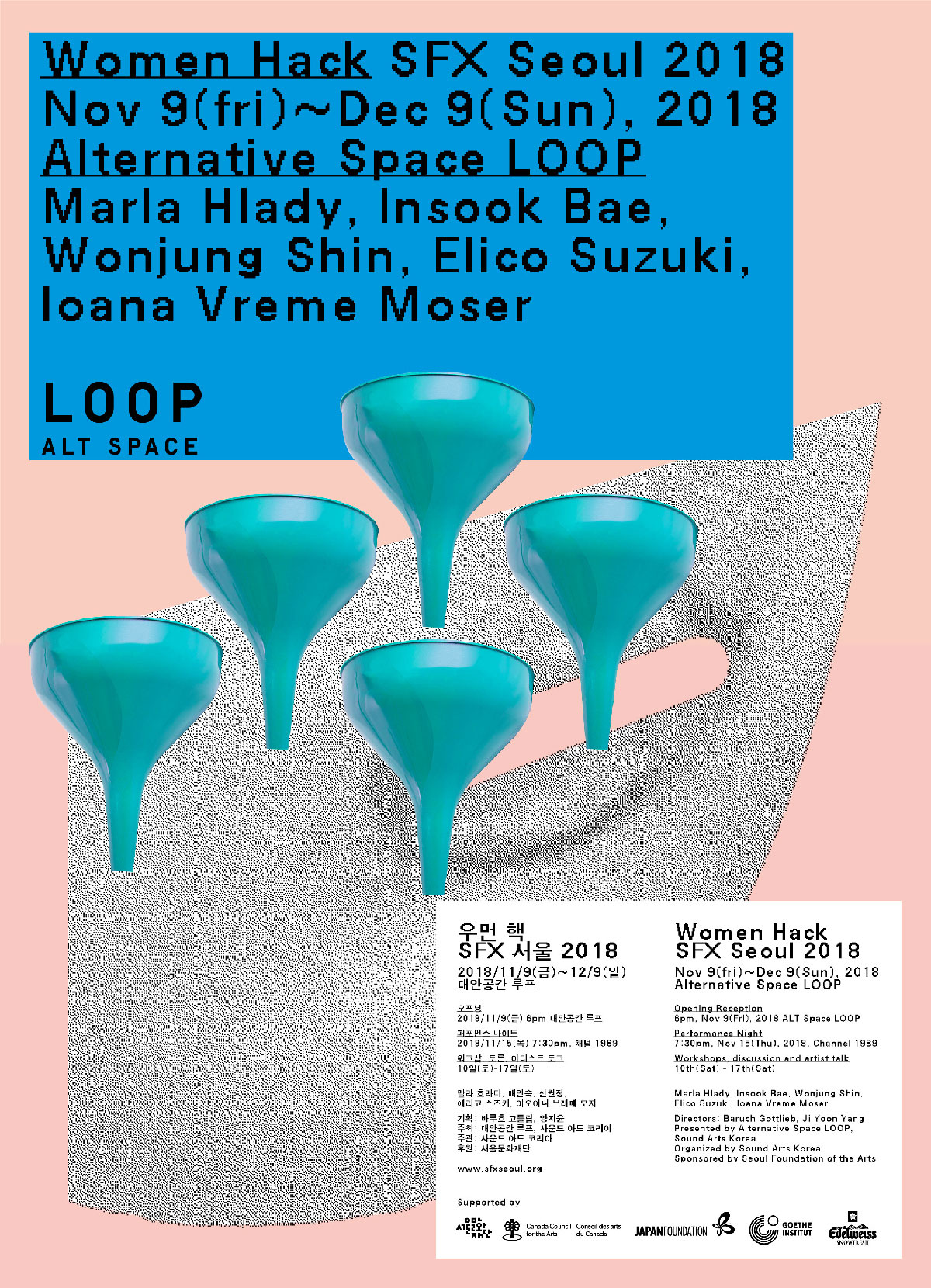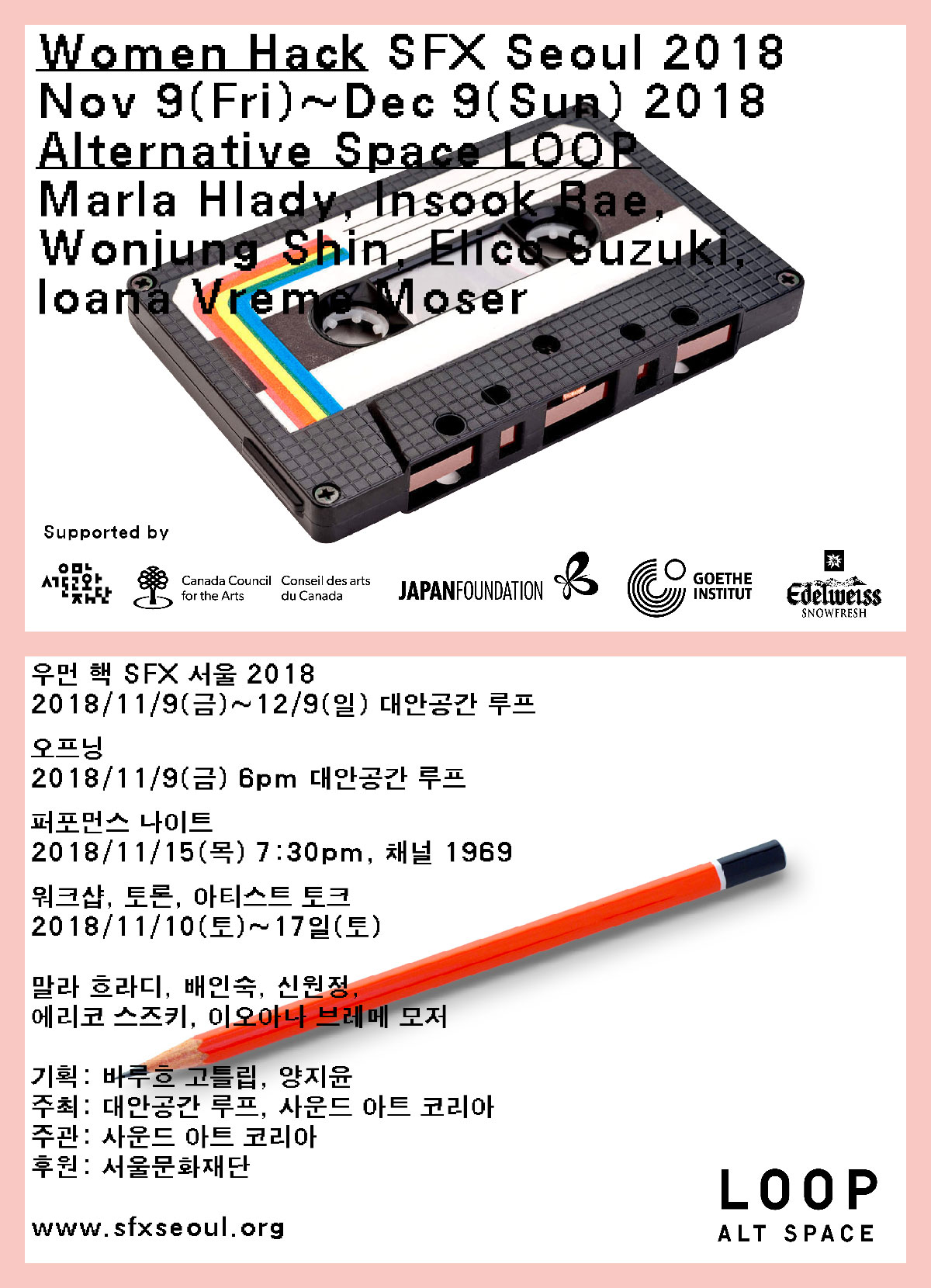







EN
KO
우먼 핵 SFX 서울 2018- 토론
시간: 2018년 11월 10일(토) 오후 2-5시
장소: 대안공간 루프
언어: 영어로 진행, 한국어 통역
참가신청: 이메일 신청 (이름, 전화번호 기재 / gallery.loop.seoul@gmail.com)
참여: 말라 흐라디, 배인숙, 신원정, 에리코 스즈키, 이오아나 브레메 모저, 바루흐 고틀립, 양지윤, 하타나카 미노루
‹우먼 핵 SFX 서울 2018› 전시 연계 행사로 토론을 진행합니다. 참여 작가, 디렉터, 초청 큐레이터와 함께 지역적이면서 국제적 맥락에서의 개인적 경험에 관해 이야기 나눕니다. 지금까지 자신들을 둘러싼 공동체 안에서 사운드 아트 작품을 제작하고 발표하면서 맞닥뜨리는 도전과 지원에 대해 이야기합니다. 각자의 예술적, 사회적 아젠다를 가지고 심층 토론이 진행됩니다.
시간: 2018년 11월 10일(토) 오후 2-5시
장소: 대안공간 루프
언어: 영어로 진행, 한국어 통역
참가신청: 이메일 신청 (이름, 전화번호 기재 / gallery.loop.seoul@gmail.com)
참여: 말라 흐라디, 배인숙, 신원정, 에리코 스즈키, 이오아나 브레메 모저, 바루흐 고틀립, 양지윤, 하타나카 미노루
‹우먼 핵 SFX 서울 2018› 전시 연계 행사로 토론을 진행합니다. 참여 작가, 디렉터, 초청 큐레이터와 함께 지역적이면서 국제적 맥락에서의 개인적 경험에 관해 이야기 나눕니다. 지금까지 자신들을 둘러싼 공동체 안에서 사운드 아트 작품을 제작하고 발표하면서 맞닥뜨리는 도전과 지원에 대해 이야기합니다. 각자의 예술적, 사회적 아젠다를 가지고 심층 토론이 진행됩니다.
Women Hack SFX Seoul 2018- Discussion
Dates: 2pm-5pm, Nov 10th (Sat), 2018
Venue: Alternative Space LOOP
Language: English with Korean Translation
Registration: Email Only (Name, Phone number / gallery.loop.seoul@gmail.com)
Participants: Marla Hlady, Insook Bae, Wonjung Shin, Elico Suzuki, Ioana Vreme Moser, Baruch Gottlieb, Ji Yoon Yang, Hatanaka Minoru
In our discussion we wish to learn from our festival artists, their experiences in their local scenes and in the international context, the challenges and support they encounter in the communities where they produce and present their work, and their own artistic and social agendas as elaborated in their practices.
Dates: 2pm-5pm, Nov 10th (Sat), 2018
Venue: Alternative Space LOOP
Language: English with Korean Translation
Registration: Email Only (Name, Phone number / gallery.loop.seoul@gmail.com)
Participants: Marla Hlady, Insook Bae, Wonjung Shin, Elico Suzuki, Ioana Vreme Moser, Baruch Gottlieb, Ji Yoon Yang, Hatanaka Minoru
In our discussion we wish to learn from our festival artists, their experiences in their local scenes and in the international context, the challenges and support they encounter in the communities where they produce and present their work, and their own artistic and social agendas as elaborated in their practices.
에리코 스즈키 워크샵: 가정용품 해킹하기!
시간: 2018년 11월 11일(일) 오후 3시-6시
장소: 대안공간 루프
언어: 영어로 진행, 한국어 통역
참가신청: 이메일 신청 (이름, 전화번호 기재 / gallery.loop.seoul@gmail.com)
준비물: 해킹할 가정용품
* 참가자는 최대 8명으로 제한됩니다. 사전에 참가신청을 이메일로 부탁드립니다.
워크샵 소개
에리코 스즈키는 자신의 작업 설명과 함께 이에 사용되는 주요 기술들을 소개합니다. 워크샵 참가자들은 자신이 가져온 배터리나 모터 등으로 구동되는 가정용품을 살피고, 이것들이 새로운 소리를 만들도록 해킹합니다. 모든 참가자는 물건에서 만들어진 소리를 함께 탐구하고 소리의 질감을 만들며, 소리를 내는 방법에 대해 토론합니다.
말라 흐라디 워크샵: 장난감 해킹하기!
시간: 2018년 11월 13일(화) 오후 5시-8시
장소: 대안공간 루프
언어: 영어로 진행, 한국어 통역
참가신청: 이메일 신청 (이름, 전화번호 기재 / gallery.loop.seoul@gmail.com)
준비물: 해킹할 기계식 장난감
* 참가자는 최대 8명으로 제한됩니다.
워크샵 소개
"기계로 작동되는 장난감을 악기로 바꾸세요"
이 워크샵의 핵심은 장난감을 해킹하는 법입니다.
어떤 도구를 사용하세요?
어디서부터 시작하세요?
어떤 종류의 변경이 가능한가요?
어떤 기술인가요?
어디서 끝나죠?
어떻게 연주할 건가요?
작가와의 대화-이오아나 브레메 모저: 화장품 해킹하기!
시간: 2018년 11월 17일(토) 오후 3시
장소: 대안공간 루프
언어: 영어로 진행, 한국어 통역
참가신청: 이메일 신청 (이름, 전화번호 기재 / gallery.loop.seoul@gmail.com)
이오아나 브레메 모저는 메이크업과 전자회로로 사운드를 만듭니다. 이오아나는 자신의 작업에 대해 설명하고 미용 기술과 그 물질에 관해 소개합니다. 또한 그녀가 화장품을 이용하여 만든 핸드메이드 악기들이 소리 내는 방식과 작동 방식을 참가자들과 함께 탐구합니다.
시간: 2018년 11월 11일(일) 오후 3시-6시
장소: 대안공간 루프
언어: 영어로 진행, 한국어 통역
참가신청: 이메일 신청 (이름, 전화번호 기재 / gallery.loop.seoul@gmail.com)
준비물: 해킹할 가정용품
* 참가자는 최대 8명으로 제한됩니다. 사전에 참가신청을 이메일로 부탁드립니다.
워크샵 소개
에리코 스즈키는 자신의 작업 설명과 함께 이에 사용되는 주요 기술들을 소개합니다. 워크샵 참가자들은 자신이 가져온 배터리나 모터 등으로 구동되는 가정용품을 살피고, 이것들이 새로운 소리를 만들도록 해킹합니다. 모든 참가자는 물건에서 만들어진 소리를 함께 탐구하고 소리의 질감을 만들며, 소리를 내는 방법에 대해 토론합니다.
말라 흐라디 워크샵: 장난감 해킹하기!
시간: 2018년 11월 13일(화) 오후 5시-8시
장소: 대안공간 루프
언어: 영어로 진행, 한국어 통역
참가신청: 이메일 신청 (이름, 전화번호 기재 / gallery.loop.seoul@gmail.com)
준비물: 해킹할 기계식 장난감
* 참가자는 최대 8명으로 제한됩니다.
워크샵 소개
"기계로 작동되는 장난감을 악기로 바꾸세요"
이 워크샵의 핵심은 장난감을 해킹하는 법입니다.
어떤 도구를 사용하세요?
어디서부터 시작하세요?
어떤 종류의 변경이 가능한가요?
어떤 기술인가요?
어디서 끝나죠?
어떻게 연주할 건가요?
작가와의 대화-이오아나 브레메 모저: 화장품 해킹하기!
시간: 2018년 11월 17일(토) 오후 3시
장소: 대안공간 루프
언어: 영어로 진행, 한국어 통역
참가신청: 이메일 신청 (이름, 전화번호 기재 / gallery.loop.seoul@gmail.com)
이오아나 브레메 모저는 메이크업과 전자회로로 사운드를 만듭니다. 이오아나는 자신의 작업에 대해 설명하고 미용 기술과 그 물질에 관해 소개합니다. 또한 그녀가 화장품을 이용하여 만든 핸드메이드 악기들이 소리 내는 방식과 작동 방식을 참가자들과 함께 탐구합니다.
Elico Suzuki Workshop: Hack your houseware!
Date: 3pm-6pm Nov 11th (Sun), 2018
Venue: Alternative Space LOOP
Registration: Email Only (Name, Phone number / gallery.loop.seoul@gmail.com)
* Workshop limited to 8 participants
* Bring an object from you home which can make sounds.
* in English with Korean Translation
About the workshop
Elico Suzuki will first describe her work and give some examples of techniques she uses. Then, you will examine together the objects you brought. Elico will help bring out the sounds from your objects. Then all participants will explore the sounds of their objects together, making sound textures and discussing ideas.
Marla Hlady Workshop: Hack your Toy!>
Date: 5pm-8pm Nov 13th (Tue), 2018
Venue: Alternative Space LOOP
Registration: Email Only (Name, Phone number / gallery.loop.seoul@gmail.com)
* Workshop limited to 8 participants
* Participants should bring their own mechanical toy to be hacked.
* in English with Korean Translation
About the workshop
“Turn your mechanical toy into an instrument”
What tools do you use?
Where do you start?
What kind of changes are possible?
What are the techniques?
Where do you end?
How do you play it?
Artist Talk- Ioana Vreme Moser: Hack your Make-up !
Date: 3pm Nov 17th (Sat), 2018
Venue: Alternative Space LOOP
Language: English with Korean Translation
Registration: Email Only (Name, Phone number / gallery.loop.seoul@gmail.com)
Ioana Vreme Moser makes sounds with make-up and circuits. She will present her hand made instruments, some of the ideas, and how they work. Participants will be invited to explore her devices, making sounds together. She will describe the context of her work and would like to discuss with you about beauty technologies.
Date: 3pm-6pm Nov 11th (Sun), 2018
Venue: Alternative Space LOOP
Registration: Email Only (Name, Phone number / gallery.loop.seoul@gmail.com)
* Workshop limited to 8 participants
* Bring an object from you home which can make sounds.
* in English with Korean Translation
About the workshop
Elico Suzuki will first describe her work and give some examples of techniques she uses. Then, you will examine together the objects you brought. Elico will help bring out the sounds from your objects. Then all participants will explore the sounds of their objects together, making sound textures and discussing ideas.
Marla Hlady Workshop: Hack your Toy!>
Date: 5pm-8pm Nov 13th (Tue), 2018
Venue: Alternative Space LOOP
Registration: Email Only (Name, Phone number / gallery.loop.seoul@gmail.com)
* Workshop limited to 8 participants
* Participants should bring their own mechanical toy to be hacked.
* in English with Korean Translation
About the workshop
“Turn your mechanical toy into an instrument”
What tools do you use?
Where do you start?
What kind of changes are possible?
What are the techniques?
Where do you end?
How do you play it?
Artist Talk- Ioana Vreme Moser: Hack your Make-up !
Date: 3pm Nov 17th (Sat), 2018
Venue: Alternative Space LOOP
Language: English with Korean Translation
Registration: Email Only (Name, Phone number / gallery.loop.seoul@gmail.com)
Ioana Vreme Moser makes sounds with make-up and circuits. She will present her hand made instruments, some of the ideas, and how they work. Participants will be invited to explore her devices, making sounds together. She will describe the context of her work and would like to discuss with you about beauty technologies.
제5회 사운드이펙트서울: 우먼 핵 SFX 서울 2018
말라 흐라디, 배인숙, 신원정, 에리코 스즈키, 이오아나 브레메 모저
개막식: 2018년 11월 9일(금) 오후 6시, 대안공간 루프
전시: 2018년 11월 9일(금)-12월 9일(일), 오전 10시–오후 7시, 대안공간 루프
토론: 2018년 11월 10일(토) 오후 2-5시, 대안공간 루프
워크샵&작가와의 대화:
2018년 11월 11일(일) 오후 3시, 에리코 스즈키, 대안공간 루프
2018년 11월 13일(화) 오후 5시, 말라 흐라디, 대안공간 루프
2018년 11월 17일(토) 오후 3시, 이오아나 브레메 모저, 대안공간 루프
퍼포먼스 나이트: 2018년 11월 15일(목) 오후 7시 30분, 채널 1969
사운드아트코리아
2006년 바루흐 고틀립과 양지윤이 공동 설립했다. 2007년부터 국제 사운드 아트 페스티벌인 ‹사운드이펙트서울›을 개최해왔다. 사운드 스케이프, 현대 음악, 노이즈, 라디오 아트와 같은 예술적 실험들을 통해 대중음악에 장악된 듣기 문화에 새로운 전망을 제시한다. 듣기 문화가 갖는 사회문화적 접점에 대해 연구하고, 또한 사운드 아트라는 예술 형식으로 반영해낸다.
크레딧
주최: 대안공간 루프, 사운드 아트 코리아
주관: 사운드 아트 코리아
후원: 서울문화재단
협력: 일본문화원, 독일문화원, 캐나다 아트 카운슬, 채널 1969, 에델바이스 코리아
사운드 아트 코리아
디렉터: 바루흐 고틀립, 양지윤
프로젝트 매니저: 이선미
코디네이터: 피지혜
미디어 디자인: 신나라
어시스턴트: 김경봉
테크니션: 문두성
디자인: 김도형
웹디자인: 최진훈
후원:





말라 흐라디, 배인숙, 신원정, 에리코 스즈키, 이오아나 브레메 모저
개막식: 2018년 11월 9일(금) 오후 6시, 대안공간 루프
전시: 2018년 11월 9일(금)-12월 9일(일), 오전 10시–오후 7시, 대안공간 루프
토론: 2018년 11월 10일(토) 오후 2-5시, 대안공간 루프
워크샵&작가와의 대화:
2018년 11월 11일(일) 오후 3시, 에리코 스즈키, 대안공간 루프
2018년 11월 13일(화) 오후 5시, 말라 흐라디, 대안공간 루프
2018년 11월 17일(토) 오후 3시, 이오아나 브레메 모저, 대안공간 루프
퍼포먼스 나이트: 2018년 11월 15일(목) 오후 7시 30분, 채널 1969
사운드아트코리아
2006년 바루흐 고틀립과 양지윤이 공동 설립했다. 2007년부터 국제 사운드 아트 페스티벌인 ‹사운드이펙트서울›을 개최해왔다. 사운드 스케이프, 현대 음악, 노이즈, 라디오 아트와 같은 예술적 실험들을 통해 대중음악에 장악된 듣기 문화에 새로운 전망을 제시한다. 듣기 문화가 갖는 사회문화적 접점에 대해 연구하고, 또한 사운드 아트라는 예술 형식으로 반영해낸다.
크레딧
주최: 대안공간 루프, 사운드 아트 코리아
주관: 사운드 아트 코리아
후원: 서울문화재단
협력: 일본문화원, 독일문화원, 캐나다 아트 카운슬, 채널 1969, 에델바이스 코리아
사운드 아트 코리아
디렉터: 바루흐 고틀립, 양지윤
프로젝트 매니저: 이선미
코디네이터: 피지혜
미디어 디자인: 신나라
어시스턴트: 김경봉
테크니션: 문두성
디자인: 김도형
웹디자인: 최진훈
후원:





The 5th Sound Effects Seoul: Women Hack SFX Seoul 2018
Marla Hlady, Insook Bae, Wonjung Shin, Elico Suzuki, Ioana Vreme Moser
Opening Reception: 6pm, Nov 9th(Fri) 2018, Alternative Space LOOP
Exhibition: Nov 9th(Fri)-Dec 9th(Sun) 2018, Alternative Space LOOP
Discussion: 2pm-5pm Nov 10th(Sat) 2018, Alternative Space LOOP
Workshops & Artist Talk:
3pm, Nov 11th(Sun) Elico Suzuki, Alternative Space LOOP
5pm, Nov 13th(Tue), Marla Hlady, Alternative Space LOOP
3pm, Nov 17th(Sat) Ioana Vreme Moser, Alternative Space LOOP
Performance Night: 7:30pm Nov 15th (Thu) 2018, Channel 1969
Credit
Presented by Alternative Space LOOP, Sound Arts Korea
Organized by Sound Arts Korea
Sponsored by Seoul Foundation of the Arts
Cooperated with Channel 1969
sfxseoul.org
Sound Arts Korea
Directors: Baruch Gottlieb, Ji Yoon Yang
Project Manager: Sun Mi Lee
Coordinator: Jihye Pi
Media Design: Nara Shin
Assistant: Kyungbong Kim
Technician: Doosung Moon
Design: Dohyung Kim
Web Design: Jinoon Choi
Supported by:





Marla Hlady, Insook Bae, Wonjung Shin, Elico Suzuki, Ioana Vreme Moser
Opening Reception: 6pm, Nov 9th(Fri) 2018, Alternative Space LOOP
Exhibition: Nov 9th(Fri)-Dec 9th(Sun) 2018, Alternative Space LOOP
Discussion: 2pm-5pm Nov 10th(Sat) 2018, Alternative Space LOOP
Workshops & Artist Talk:
3pm, Nov 11th(Sun) Elico Suzuki, Alternative Space LOOP
5pm, Nov 13th(Tue), Marla Hlady, Alternative Space LOOP
3pm, Nov 17th(Sat) Ioana Vreme Moser, Alternative Space LOOP
Performance Night: 7:30pm Nov 15th (Thu) 2018, Channel 1969
Credit
Presented by Alternative Space LOOP, Sound Arts Korea
Organized by Sound Arts Korea
Sponsored by Seoul Foundation of the Arts
Cooperated with Channel 1969
sfxseoul.org
Sound Arts Korea
Directors: Baruch Gottlieb, Ji Yoon Yang
Project Manager: Sun Mi Lee
Coordinator: Jihye Pi
Media Design: Nara Shin
Assistant: Kyungbong Kim
Technician: Doosung Moon
Design: Dohyung Kim
Web Design: Jinoon Choi
Supported by:





우먼 핵 SFX 서울 2018
일정: 2018년 11월 9일(금)-12월 9일(일), 오전 10시–오후 7시
개막식: 2018년 11월 9일(금) 오후 6시
장소: 대안공간 루프
참여작가: 말라 흐라디, 배인숙, 신원정, 에리코 스즈키, 이오아나 브레메 모저
축제 소개
제5회 사운드이펙트서울 ‹우먼 핵 SFX 서울 2018Women Hack SFX Seoul 2018›의 주제는 ‘여성, 하드웨어, 사운드’다. 여성이라는 주체를 사회적 산물로 놓고 젠더와 듣기 문화 사이의 관계에 집중한다. 참여 작가는 전원 여성으로 구성되었다.
예술가의 예술적 실천을 위한 필수불가결한 조건 중 하나는 제작의 기술을 익히는 일이다. 특히 설치와 조각을 주요 매체로 다루는 예술가들에게 목공과 철공, 전기와 기계 장비들을 익히는 일은 제 창작과 직접적으로 연결되어 있다. 일반적으로 여성들은 신체적 조건이나 뇌의 특징 상 이런 제작 기술과 기능에 덜 최적화되어 있다는 선입견이 존재했다. ‹우먼 핵 SFX 서울 2018›에 참여하는 ‘여성 예술가’들은 이러한 선입견에 맞서 제 예술적 역량을 드러내온 ‘베테랑 기술자’들이다. ‘하드웨어 해커’인 그들은 하드웨어를 분해하거나 재조립하여 자신만의 소리를 만들어낸다.
‹우먼 핵 SFX 서울 2018›이 열리는 홍대 지역은 한국 인디 음악의 본산이자, 다양한 클럽 등 청년 문화의 거점으로 인식되었다. 2000년대 이후 상업 자본이 대거 유입되면서 홍대는 관광지화되어갔고, 젠트리피케이션으로 인하여 예술의 문화적 가치가 전면적으로 변이되었다. ‹우먼 핵 SFX 서울 2018›은 지금 한국의 듣기 문화가 ‘산업적 대중 음악’에 장악된 상황에 대한 예술적 대응이다. 아이돌로 대변되는 한국의 대중음악 문화는 이성애적 성 역할을 강요하고 신자유주의적 시장질서와 신분 체계를 노골화한다. ‹우먼 핵 SFX 서울 2018›은 자신만의 소리 문화를 만드는, 수용자가 아닌 창작자로서 미감과 정체성을 재고한다. 홍대 지역에서 새로운 청각 문화를 생성하고자 한다.
하드웨어를 해킹하여 사운드 기계를 만드는 ‘DIY 악기 제작 워크샵’과 ‘사운드 퍼포먼스 나이트’도 열린다. ‘여성적 사운드’에 대한 미적 고민과 함께, 홍대 지역 시각 예술가와 음악가들이 만나는 플랫폼이 되길 기대한다.
참여작가와 작업
말라 흐라디
말라 흐라디는 그림을 그리고, 조각을 만들며, 사이트와 소리로 작업하고 때로는 비디오를 만든다. 말라의 키네틱 아트와 사운드 설치는 시스템 기반의 구성 방식을 사용하여 예상치 못한 음향 및 시적 속성을 드러내기 위해 확장된 개체 (주전자, 칵테일 믹서, 병과 같은)로 구성된다. 말라 흐라디는 다수의 개인전과 그룹전을 진행했으며 종종 콜라보 작업을 선보이기도 한다. 노르웨이의 피요르드 (phjords), 베를린 아파트의 창문, 오타와 (Ottawa)의 투어 버스, 사운드 페스티벌 ‹Electric Eclectic›의 일환이었던 곡물 저장소에 작업을 설치했다. 토론토 대학교에서 비주얼 스터디를 전공했으며, 현재 토론토 대학교에서 강의를 하고 있다.
두 개의 기타 앰프-기계는 기계식 장난감, 전시공간 등 각각의 소리를 회전시키고 변위 시켜 키네틱 구조로 바꾼다. 이 앰프는 ‹악기 프로젝트›의 일부이며 ‹악기 프로젝트›의 질문은 다음과 같다. 악기로 둘러싸인다면 어떨까? 악기의 일부가 스스로 움직인다면 어떨까? 그리고 이 악기가 다른 장소에 있을 수 있다면 어떻게 될까? 이동가능성(Portability)은 다채로운 음향 환경을 탐험할 수 있게 하며, 소리/악기로 사회에 대항한다.
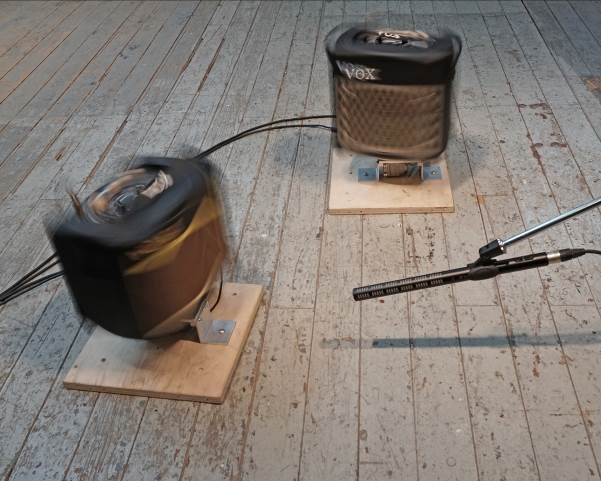 스핀사이클, 사운드 설치, 2018
스핀사이클, 사운드 설치, 2018
말라 흐라디의 작업은 사운드와 키네틱에 기반한 조각과 설치 작업을 포함한다. 조각은 모터, 마이크로 프로세서 및 오디오에서 나무, 금속 또는 발견된 물건에 이르기까지 다양한 재료와 형식으로 구성된다. 말라의 조각과 설치는 문자의 움직임, 또는 대상의 사용능력을 기능화함으로써 효용에 대한 아이디어를 꾸준히 다룬다. 말라는 우리가 기대하는 대상의 기능을 변화시킨다. 독립적인 조각이나 설치 여부에 관계없이 방문자가 직접 작업을 활성화시키고 상호작용 하도록 초대하는 방식은 기능적 이해를 위한 작업의 일부이다. 궁극적으로 작품과 공간, 그리고 작품에 관심을 갖는 방문객(육체와 사회 구조 모두)의 의미 사이의 관계이다.
배인숙
사운드 인터렉션, 소리장치를 활용한 공연, 일상의 소리, 음악적 소음을 주제로 한 설치, 공연을 해오고 있다. 2012년부터 사운드 퍼포먼스 그룹 ‘업사이클 라운드업’과 실험시도 음악회인 ‘하울링’에서 활동하고 있으며, 2013년 서울문화재단의 유망예술지원 MAP에 선정되어 ‹사운딩 사운더›를 기획, 전시했다. 그 밖에 ‹뮤트 오프, 갤러리 라한, 2014›, ‹리스펙트 오디오, 17717, 2015›, ‹아오병잉 페스티벌, 서울연극센터, 2016›, ‹만보객의 서울유랑, 거리예술창작센터, 2016›에 참여했으며, 인천아트플랫폼 백령 레지던시 입주작가로 활동했다.
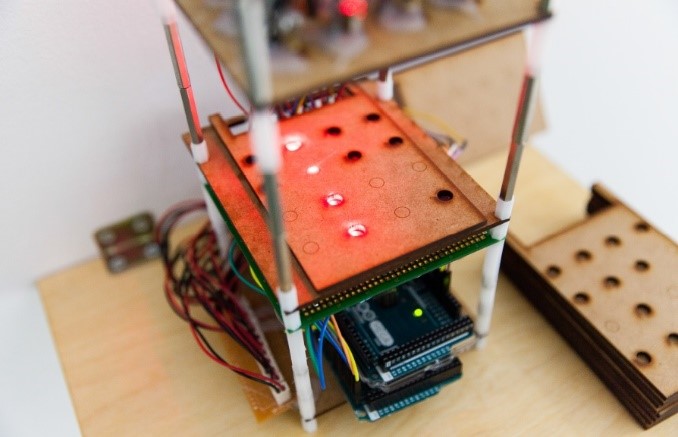 리더(Reader), 사운드 설치, 2018
리더(Reader), 사운드 설치, 2018
소리를 재생하거나 정보를 읽는 장치인 카세트 플레이어, 시디롬, 하드디스크, 플로피 디스크의 소리와 움직임을 데이터로 입력받아 음악이 만들어진다. 리더(Reader)는 개별적인 장치들의 소리를 유기적으로 연결하고 음악적 데이터로 가공하여 멜로디와 리듬을 만들어내는 작곡기계이자 플레이어다.
신원정
신원정은 사물, 매체, 상황, 그리고 리듬을 만드는 아티스트로 물질과 비물질, 사물, 그리고 사건 등 다양한 요소를 접목시켜 공간과 시간을 채운다. ‹신호수, 광주미디어아트페스티벌, 2017›, ‹사이버네틱 환상: 우리의 밝은 미래, 백남준 아트센터, 용인, 2017›, ‹사물학ll: 제작자들의 도시, 국립현대미술관, 과천, 2015› 등의 주요 전시에 참여했으며, ‹시티즌밴드, 안산국제거리축제, 2017›, ‹모두의 메가폰, 콜트콜텍 노동자들의 수요문화제, 서울, 2016› 등 다수의 공동체 사운드 프로젝트를 진행했다. 작가는 관객을 작품의 적극적인 개입자로 초대하여 몸과 감각의 보편적 소통을 시도한다. 관계적 미학을 향한 미디어 아트를 실험하는 듀오 ‘다이애나 밴드’의 멤버이다.
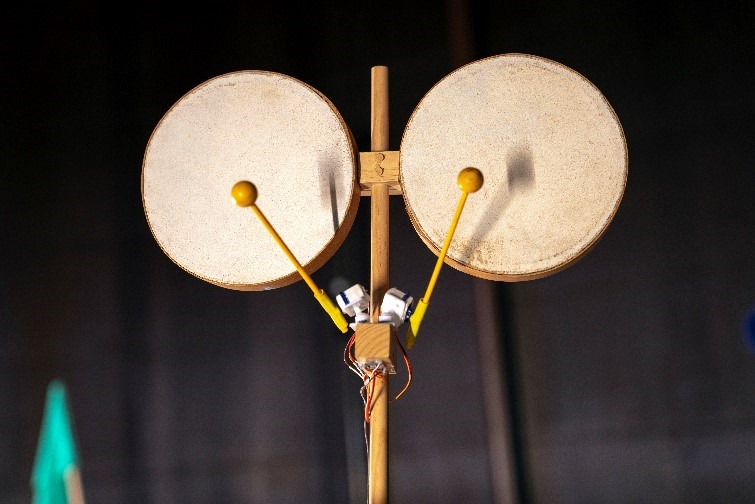 소란, 사운드 설치, 2018
소란, 사운드 설치, 2018
목소리를 들어줄 사람이 없다면 대나무 숲으로 간다. 온몸을 울리며 목소리를 내고 나면 대나무 숲은 목소리를 기억한다. 대나무 숲의 소리는 목소리를 삼키고 적절한 시기에 그 목소리를 내놓으리라는 믿음으로 인간과 대나무 숲은 모종의 심리적 연대를 나눈다.
‹소란›은 일시적으로 만난 인간이 사물, 환경, 매체를 통해 음성적 대화를 시도하는 작업이다. 특정 상황과 웹공간에 놓인 관람자는 다른 관람자와 같은 소통의 플랫폼과 인터페이스를 공유하면서, 물리적 공간 안에 울리는 소리들에 동의를 표하거나 소리의 성질을 조율하면서, 공동의 소리를 만든다. 소리들의 질감과 패턴들이 뒤엉켜 만들어지는 소리의 풍경은 사람들의 목소리를 대변하고 심리적 연대를 제공한다. 8개의 스피커와 물리적 소리장치를 가진 사물들은 공간에서 일상의 모습을 하고 있다. 관람자는 자신의 스마트기기를 통해 특정 웹페이지로 접속할 것을 제안받는다. 웹페이지는 동시에 접속한 관람자들에게 공동의 스크롤, 선택버튼을 제공함으로써 공동의 인터페이스의 역할을 한다. 하나의 스크롤바를 동시 접속한 여러 명의 관람자가 조정하면 공간에 배치해 둔 사물들의 소리가 출현하거나, 소리의 성질이 다양하게 조율된다.
에리코 스즈키
에리코 스즈키는 1970년 생으로 일본 도쿄에서 활동하는 미디어 아티스트이다. 무사시노 미술 대학에서 미디어를 전공한 스즈키는 음악과 뉴미디어를 결합한 악기 제작, 사운드 아트 작업을 선보이고 있다. 개인전 ‹융프라우의 달, NTT 인터커뮤니케이션 센터, 도쿄, 2007›, ‹프리페어드, 기프트랩, 도쿄, 2010›, ‹재귀 피아노 20202, 도쿄, 2013›을 개최했으며 ‹코미마루 쇼, 스이타 역사문화진흥센터, 오사카, 2011›, ‹소리의 정원, 스트라이프드 하우스 뮤지엄, 도쿄, 1993›등 주요 단체전에 참여했다.
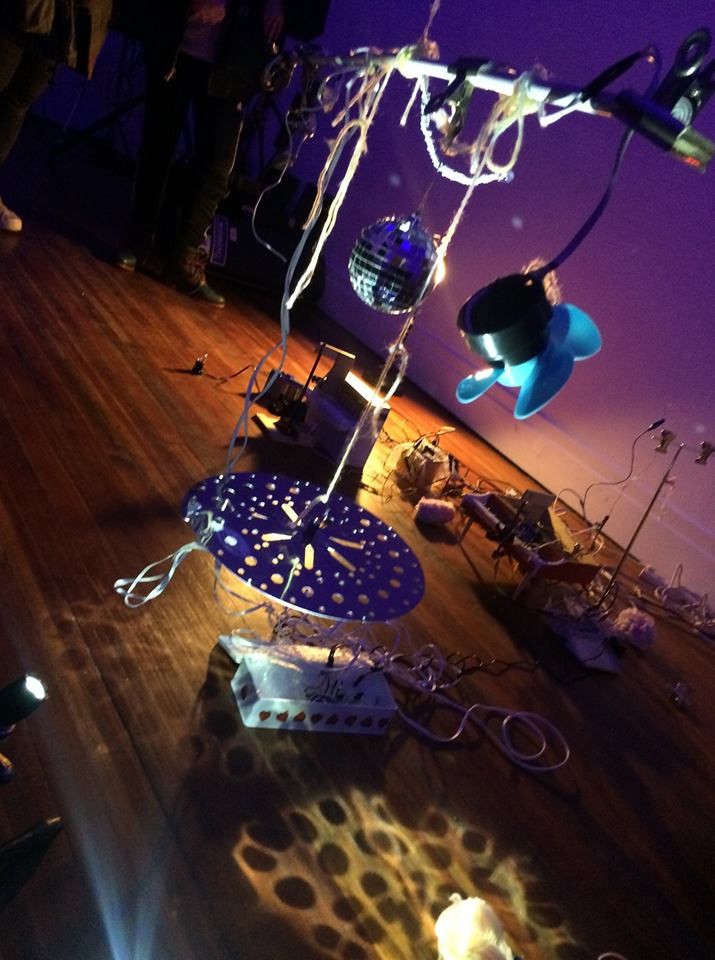 세 가지 세계, 사운드 설치, 2018
세 가지 세계, 사운드 설치, 2018
작품 제목 ‹세 가지 세계›는 모리츠 코르넬리스 에셔(Maurits Cornelis Escher)의 판화에서 차용했다. 작품에서 세 가지 세계는 물체와 관객이 움직이는 실제 공간, 움직이는 물체와 조명의 그림자 그리고 모터와 라디오의 전자기파이다. 모바일의 움직임은 모바일과 팬의 반력에 의해 발생한다. 라디오 소리는 팬의 모터에 의한 전자파의 간섭에 따라 변화된다. 이 모바일 오브제의 원형은 주로 에리코의 사운드 퍼포먼스에 사용되며 이번 작품은 한 달 여에 걸쳐 다시 제작됐다.
이오아나 브레메 모저
베를린을 기반으로 활동하는 루마니아 태생의 미디어 아티스트이다. 시각적인 감지와 오디오 매체 사이의 상호 관계와 경계를 탐구한다. 디지털과 아날로그 기술을 사용하여 눈에 띄지 않는 일상적인 습관의 작은 사건들을 드러낸다. 최근 키네틱 설치, 사운드, 작은 전자조각, 내레이션, 텍스트, 애니메이션 등 다양한 매체를 사용하여 작업을 확장시키고 있다.
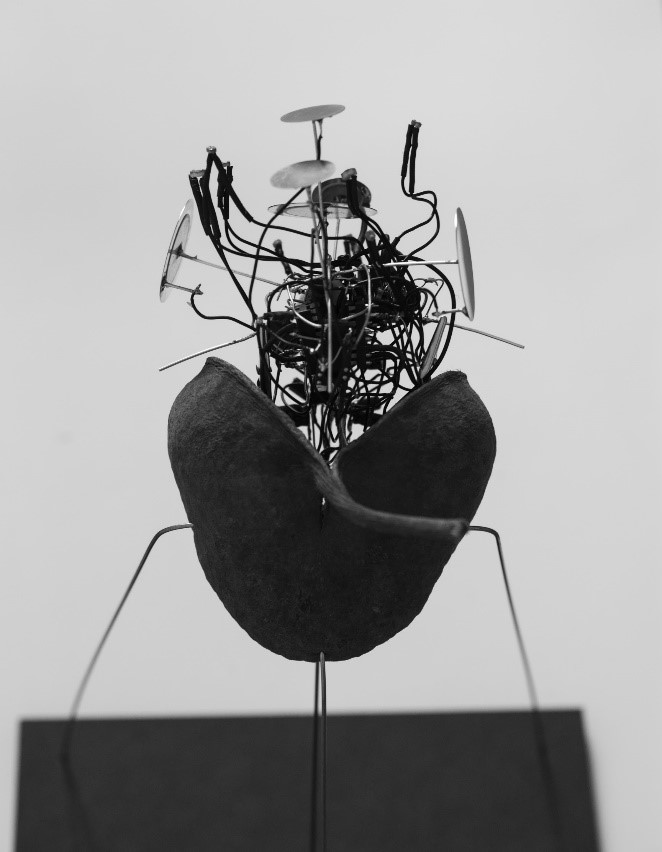 Zurkubuk, Nux Stridens, klangobjekt – 회로도, 2017
Zurkubuk, Nux Stridens, klangobjekt – 회로도, 2017
야행성 도시 거주자 메뚜기는 프테리고타 알라타타(Pterygota Alatata: 열매의 종류)의 껍질에 서식한다. 자극을 받으면 메뚜기는 거친 기계적인 소리를 낸다. 신체 부위를 서로 부드럽게 문지르면 찌르륵 울기 시작한다. 발진기의 진동은 우연적으로 등장하여 압전센서에 따라 리드미컬한 구호처럼 연속적으로 변조된다. 표현력과 강도가 다양하며 소통과 근접성에 대한 욕구를 따른다.
일정: 2018년 11월 9일(금)-12월 9일(일), 오전 10시–오후 7시
개막식: 2018년 11월 9일(금) 오후 6시
장소: 대안공간 루프
참여작가: 말라 흐라디, 배인숙, 신원정, 에리코 스즈키, 이오아나 브레메 모저
축제 소개
제5회 사운드이펙트서울 ‹우먼 핵 SFX 서울 2018Women Hack SFX Seoul 2018›의 주제는 ‘여성, 하드웨어, 사운드’다. 여성이라는 주체를 사회적 산물로 놓고 젠더와 듣기 문화 사이의 관계에 집중한다. 참여 작가는 전원 여성으로 구성되었다.
예술가의 예술적 실천을 위한 필수불가결한 조건 중 하나는 제작의 기술을 익히는 일이다. 특히 설치와 조각을 주요 매체로 다루는 예술가들에게 목공과 철공, 전기와 기계 장비들을 익히는 일은 제 창작과 직접적으로 연결되어 있다. 일반적으로 여성들은 신체적 조건이나 뇌의 특징 상 이런 제작 기술과 기능에 덜 최적화되어 있다는 선입견이 존재했다. ‹우먼 핵 SFX 서울 2018›에 참여하는 ‘여성 예술가’들은 이러한 선입견에 맞서 제 예술적 역량을 드러내온 ‘베테랑 기술자’들이다. ‘하드웨어 해커’인 그들은 하드웨어를 분해하거나 재조립하여 자신만의 소리를 만들어낸다.
‹우먼 핵 SFX 서울 2018›이 열리는 홍대 지역은 한국 인디 음악의 본산이자, 다양한 클럽 등 청년 문화의 거점으로 인식되었다. 2000년대 이후 상업 자본이 대거 유입되면서 홍대는 관광지화되어갔고, 젠트리피케이션으로 인하여 예술의 문화적 가치가 전면적으로 변이되었다. ‹우먼 핵 SFX 서울 2018›은 지금 한국의 듣기 문화가 ‘산업적 대중 음악’에 장악된 상황에 대한 예술적 대응이다. 아이돌로 대변되는 한국의 대중음악 문화는 이성애적 성 역할을 강요하고 신자유주의적 시장질서와 신분 체계를 노골화한다. ‹우먼 핵 SFX 서울 2018›은 자신만의 소리 문화를 만드는, 수용자가 아닌 창작자로서 미감과 정체성을 재고한다. 홍대 지역에서 새로운 청각 문화를 생성하고자 한다.
하드웨어를 해킹하여 사운드 기계를 만드는 ‘DIY 악기 제작 워크샵’과 ‘사운드 퍼포먼스 나이트’도 열린다. ‘여성적 사운드’에 대한 미적 고민과 함께, 홍대 지역 시각 예술가와 음악가들이 만나는 플랫폼이 되길 기대한다.
참여작가와 작업
말라 흐라디
말라 흐라디는 그림을 그리고, 조각을 만들며, 사이트와 소리로 작업하고 때로는 비디오를 만든다. 말라의 키네틱 아트와 사운드 설치는 시스템 기반의 구성 방식을 사용하여 예상치 못한 음향 및 시적 속성을 드러내기 위해 확장된 개체 (주전자, 칵테일 믹서, 병과 같은)로 구성된다. 말라 흐라디는 다수의 개인전과 그룹전을 진행했으며 종종 콜라보 작업을 선보이기도 한다. 노르웨이의 피요르드 (phjords), 베를린 아파트의 창문, 오타와 (Ottawa)의 투어 버스, 사운드 페스티벌 ‹Electric Eclectic›의 일환이었던 곡물 저장소에 작업을 설치했다. 토론토 대학교에서 비주얼 스터디를 전공했으며, 현재 토론토 대학교에서 강의를 하고 있다.
두 개의 기타 앰프-기계는 기계식 장난감, 전시공간 등 각각의 소리를 회전시키고 변위 시켜 키네틱 구조로 바꾼다. 이 앰프는 ‹악기 프로젝트›의 일부이며 ‹악기 프로젝트›의 질문은 다음과 같다. 악기로 둘러싸인다면 어떨까? 악기의 일부가 스스로 움직인다면 어떨까? 그리고 이 악기가 다른 장소에 있을 수 있다면 어떻게 될까? 이동가능성(Portability)은 다채로운 음향 환경을 탐험할 수 있게 하며, 소리/악기로 사회에 대항한다.
 스핀사이클, 사운드 설치, 2018
스핀사이클, 사운드 설치, 2018말라 흐라디의 작업은 사운드와 키네틱에 기반한 조각과 설치 작업을 포함한다. 조각은 모터, 마이크로 프로세서 및 오디오에서 나무, 금속 또는 발견된 물건에 이르기까지 다양한 재료와 형식으로 구성된다. 말라의 조각과 설치는 문자의 움직임, 또는 대상의 사용능력을 기능화함으로써 효용에 대한 아이디어를 꾸준히 다룬다. 말라는 우리가 기대하는 대상의 기능을 변화시킨다. 독립적인 조각이나 설치 여부에 관계없이 방문자가 직접 작업을 활성화시키고 상호작용 하도록 초대하는 방식은 기능적 이해를 위한 작업의 일부이다. 궁극적으로 작품과 공간, 그리고 작품에 관심을 갖는 방문객(육체와 사회 구조 모두)의 의미 사이의 관계이다.
배인숙
사운드 인터렉션, 소리장치를 활용한 공연, 일상의 소리, 음악적 소음을 주제로 한 설치, 공연을 해오고 있다. 2012년부터 사운드 퍼포먼스 그룹 ‘업사이클 라운드업’과 실험시도 음악회인 ‘하울링’에서 활동하고 있으며, 2013년 서울문화재단의 유망예술지원 MAP에 선정되어 ‹사운딩 사운더›를 기획, 전시했다. 그 밖에 ‹뮤트 오프, 갤러리 라한, 2014›, ‹리스펙트 오디오, 17717, 2015›, ‹아오병잉 페스티벌, 서울연극센터, 2016›, ‹만보객의 서울유랑, 거리예술창작센터, 2016›에 참여했으며, 인천아트플랫폼 백령 레지던시 입주작가로 활동했다.
 리더(Reader), 사운드 설치, 2018
리더(Reader), 사운드 설치, 2018소리를 재생하거나 정보를 읽는 장치인 카세트 플레이어, 시디롬, 하드디스크, 플로피 디스크의 소리와 움직임을 데이터로 입력받아 음악이 만들어진다. 리더(Reader)는 개별적인 장치들의 소리를 유기적으로 연결하고 음악적 데이터로 가공하여 멜로디와 리듬을 만들어내는 작곡기계이자 플레이어다.
신원정
신원정은 사물, 매체, 상황, 그리고 리듬을 만드는 아티스트로 물질과 비물질, 사물, 그리고 사건 등 다양한 요소를 접목시켜 공간과 시간을 채운다. ‹신호수, 광주미디어아트페스티벌, 2017›, ‹사이버네틱 환상: 우리의 밝은 미래, 백남준 아트센터, 용인, 2017›, ‹사물학ll: 제작자들의 도시, 국립현대미술관, 과천, 2015› 등의 주요 전시에 참여했으며, ‹시티즌밴드, 안산국제거리축제, 2017›, ‹모두의 메가폰, 콜트콜텍 노동자들의 수요문화제, 서울, 2016› 등 다수의 공동체 사운드 프로젝트를 진행했다. 작가는 관객을 작품의 적극적인 개입자로 초대하여 몸과 감각의 보편적 소통을 시도한다. 관계적 미학을 향한 미디어 아트를 실험하는 듀오 ‘다이애나 밴드’의 멤버이다.
 소란, 사운드 설치, 2018
소란, 사운드 설치, 2018목소리를 들어줄 사람이 없다면 대나무 숲으로 간다. 온몸을 울리며 목소리를 내고 나면 대나무 숲은 목소리를 기억한다. 대나무 숲의 소리는 목소리를 삼키고 적절한 시기에 그 목소리를 내놓으리라는 믿음으로 인간과 대나무 숲은 모종의 심리적 연대를 나눈다.
‹소란›은 일시적으로 만난 인간이 사물, 환경, 매체를 통해 음성적 대화를 시도하는 작업이다. 특정 상황과 웹공간에 놓인 관람자는 다른 관람자와 같은 소통의 플랫폼과 인터페이스를 공유하면서, 물리적 공간 안에 울리는 소리들에 동의를 표하거나 소리의 성질을 조율하면서, 공동의 소리를 만든다. 소리들의 질감과 패턴들이 뒤엉켜 만들어지는 소리의 풍경은 사람들의 목소리를 대변하고 심리적 연대를 제공한다. 8개의 스피커와 물리적 소리장치를 가진 사물들은 공간에서 일상의 모습을 하고 있다. 관람자는 자신의 스마트기기를 통해 특정 웹페이지로 접속할 것을 제안받는다. 웹페이지는 동시에 접속한 관람자들에게 공동의 스크롤, 선택버튼을 제공함으로써 공동의 인터페이스의 역할을 한다. 하나의 스크롤바를 동시 접속한 여러 명의 관람자가 조정하면 공간에 배치해 둔 사물들의 소리가 출현하거나, 소리의 성질이 다양하게 조율된다.
에리코 스즈키
에리코 스즈키는 1970년 생으로 일본 도쿄에서 활동하는 미디어 아티스트이다. 무사시노 미술 대학에서 미디어를 전공한 스즈키는 음악과 뉴미디어를 결합한 악기 제작, 사운드 아트 작업을 선보이고 있다. 개인전 ‹융프라우의 달, NTT 인터커뮤니케이션 센터, 도쿄, 2007›, ‹프리페어드, 기프트랩, 도쿄, 2010›, ‹재귀 피아노 20202, 도쿄, 2013›을 개최했으며 ‹코미마루 쇼, 스이타 역사문화진흥센터, 오사카, 2011›, ‹소리의 정원, 스트라이프드 하우스 뮤지엄, 도쿄, 1993›등 주요 단체전에 참여했다.
 세 가지 세계, 사운드 설치, 2018
세 가지 세계, 사운드 설치, 2018작품 제목 ‹세 가지 세계›는 모리츠 코르넬리스 에셔(Maurits Cornelis Escher)의 판화에서 차용했다. 작품에서 세 가지 세계는 물체와 관객이 움직이는 실제 공간, 움직이는 물체와 조명의 그림자 그리고 모터와 라디오의 전자기파이다. 모바일의 움직임은 모바일과 팬의 반력에 의해 발생한다. 라디오 소리는 팬의 모터에 의한 전자파의 간섭에 따라 변화된다. 이 모바일 오브제의 원형은 주로 에리코의 사운드 퍼포먼스에 사용되며 이번 작품은 한 달 여에 걸쳐 다시 제작됐다.
이오아나 브레메 모저
베를린을 기반으로 활동하는 루마니아 태생의 미디어 아티스트이다. 시각적인 감지와 오디오 매체 사이의 상호 관계와 경계를 탐구한다. 디지털과 아날로그 기술을 사용하여 눈에 띄지 않는 일상적인 습관의 작은 사건들을 드러낸다. 최근 키네틱 설치, 사운드, 작은 전자조각, 내레이션, 텍스트, 애니메이션 등 다양한 매체를 사용하여 작업을 확장시키고 있다.
 Zurkubuk, Nux Stridens, klangobjekt – 회로도, 2017
Zurkubuk, Nux Stridens, klangobjekt – 회로도, 2017야행성 도시 거주자 메뚜기는 프테리고타 알라타타(Pterygota Alatata: 열매의 종류)의 껍질에 서식한다. 자극을 받으면 메뚜기는 거친 기계적인 소리를 낸다. 신체 부위를 서로 부드럽게 문지르면 찌르륵 울기 시작한다. 발진기의 진동은 우연적으로 등장하여 압전센서에 따라 리드미컬한 구호처럼 연속적으로 변조된다. 표현력과 강도가 다양하며 소통과 근접성에 대한 욕구를 따른다.
Women Hack SFX Seoul 2018
Artists: Marla Hlady, Insook Bae, Wonjung Shin, Elico Suzuki, Ioana Vreme Moser Opening Reception: 6 pm Nov 9th (Fri) 2018, Alternative Space LOOP Exhibition: Nov 9th (Fri)-Dec 9th, 2018(Sun), Alternative Space LOOP
About the festival
The theme of Women Hack SFX Seoul 2018 is Woman, Hardware, Sound. In this fifth installment of SFX Seoul, the festival addresses Woman as a social construct and explores the link and dynamics between gender and sound culture. All participating artists of Women Hack SFX Seoul 2018 are women.
One necessary condition of artistic practice is the artist’s mastery of, or familiarity with, production techniques. For installation or sculpture artists in particular, the adoption of woodworking and metalwork skills along with the ability to handle electrical and mechanical devices are crucial to their creative process. For much of the past, the presumption has been that women are less suited to such technical work and less likely to learn and master skills necessary for artistic production due to certain ‘inherent’ physical traits or characteristics that are supposedly hardwired into the brain. Each of the ‘women’ artists participating in Women Hack SFX Seoul 2018 is also a seasoned technician who has continuously demonstrated their artistic capabilities in the face of such stereotyping. These are ‘hardware hackers’ who create their own individual sound by dismantling or reassembling hardware.
The neighborhood of Hongdae, home to SFX 2018, has been central to the development of the Korean indie music scene, and long been regarded as the mainstay of youth and club culture. With the large influx of commercial capital in the 2000s, the area has undergone a lot of changes, seeing increasing gentrification and flocks of descending tourists, and has witnessed a rapid transformation of the cultural value of art. Women Hack SFX Seoul 2018 is an artistic response to the current domination of Korean sound culture by industry-backed commercial pop music. Korean pop music culture and the figure of the ‘idol’ singers that have come to represent this culture enforce heteronormative gender roles and make explicit market-oriented neoliberal values and class- or status-based hierarchies. Women Hack SFX Seoul 2018 reconsiders the aesthetic sensibilities and identities of artists involved in the making of independent sound cultures as creators rather than consumers, in a bid to foster a new auditory culture in the Hongdae area.
This year’s festival includes a Make Your Own Musical Instrument DIY Workshop, in which participants can create their own sound machines by hacking hardware, and a Sound Performance Night. We hope these platforms will provide visual artists and musicians of Hongdae the space to explore together various artistic concerns, questions, and possibilities in relation to ‘women’s sound’. Trans. by Emily Yaewon Lee
About the Artists & Artworks
Marla Hlady
Marla Hlady (b. 1965, Canada) draws, makes sculpture, works with sites and sounds and sometimes makes video. Hlady's kinetic sculptures and sound pieces often consist of common objects (such as teapots, cocktail mixers, jars) that are expanded and animated to reveal unexpected sonic and poetic properties often using a system-based approach to composition. She’s shown widely in solo and group shows. She has mounted site works in such places as the fjords of Norway, a grain silo as part of the sound festival Electric Eclectic, an apartment window in Berlin, a tour bus in Ottawa. She also, at times, collaborates. She currently lectures in the Department of Arts, Culture and Media (University of Toronto at Scarborough) and the Graduate Faculty in Visual Studies (Daniels Faculty of Architecture, Landscape and Design, University of Toronto).
Two guitar amplifiers-as-machines twirl, turn, shift and displace the sounds of mechanical toys, the gallery space, and each other into a choreographed composition. The amplifiers are part of The Instrument Project, a project that asks questions such as: What would it be like to be surrounded by an instrument? What if some of these parts moved on their own? And what would happen if this instrument could be situated in different places? Portability allows an exploration of different acoustic environments. Portability also pushes sounds/instruments up against various social worlds.
 Spincycle, 2018
Spincycle, 2018
Marla’s practice predominantly involves audio and kinetic based sculpture and sculptural site and installation works. The sculptural pieces take on a myriad of forms and are made of a variety of materials ranging from motors, microprocessors and audio to wood, metal and found objects. She consistently addresses the idea of utility in her works by making sculptures and installations function, literally with kinetics or through the use-ability of the object. Her work, however, alters the function we expect from the things they resemble. Whether an independent sculpture or an installation, how a visitor activates or is invited to interact with a work is a part of the functional understanding of the work. Ultimately, it’s the relationships between the work, the space it occupies and the implications of the visitor (both a physical body and a social construction) that interests the work.
Insook Bae
Insook Bae (b. 1975, Korea) performances with interacting apparatuses, everyday sounds and musical noises. Since 2012 she performs as member of the experimental groups group 'Upcycle Roundup' and ‘Howling'. In 2013, she was selected as ‘MAP’ emerging artist supported by the Seoul Foundation for Culture and participated in the exhibition Sounding Sounder. She also participated in Mute off (Gallery RAHAN, Seoul, 2014), Respect Audio (17717, Seoul, 2015), Aobyonging Festival (Seoul Theater Center, 2016). She is currently artist in residence at the Incheon Art Platform Baekryung.
 Reader, Sound Installation, 2018
Reader, Sound Installation, 2018
The music is created by inputting the sound and movement of a cassette player, a CD-ROM, a hard disk, and a floppy disk which are all devices reading information which can be interpreted as sound. The Reader is a composition-machine and player that organically connects the sounds of individual devices and processes them into musical data producing melodies and rhythms.
Wonjung Shin
Wonjung Shin (b, 1981, Korea) is an artist who creates objects, media, situations, and rhythms. Her compositions of various material & ephemeral objects, and events interact with space and time. She has participated in major exhibitions such as Signal Trees (Gwangju Media Arts Festival, 2017), Cybernetic Fantasy: Our Bright Future (Nam June Paik Art Center, Yongin, 2017), Objectology ll: (National Museum of Modern and Contemporary Art, Gwacheon, 2015) and she has performed in a number of community sound projects including Citizen Band (Ansan International Street Festival, 2017), Megaphone of All, Wednesday Culture Festival for Colt Coltek Workers (Seoul, 2016). Wonjung is working towards a universal communication with the body and the senses and invites the visitors to actively engage in the work. She is a member of the duo 'Diana Band' whose practice explores experimental media art for relational aesthetics.
 Commotion, Sound Installation, 2018
Commotion, Sound Installation, 2018
If there is no one to listen to the voice, go to the bamboo forest. The bamboo forest remembers the voices after the vocal bodies have gone silent. Believing that the bamboo forest will swallow the voices and spit them out at the right time, humans and bamboo forests share some kind of psychological solidarity.
Commotion is a work of a human who tries to communicate through the voices of objects, the environment and the medium. The visitor, in certain situations and in the web space share a common interface with other visitors, creating common sounds, convening around the sounds in the physical space or the nature of the sounds. The sound landscape where the textures and patterns of the sounds are intertwined represents the people voices and provides psychological solidarity. Eight speakers and objects with a physical sound device have an everyday appearance. Visitors are offered access to a specific web page via their smart device. The web page serves as a common interface by providing common scroll and selection buttons to visitors who are connected at the same time. When several visitors, connected at the same time, adjust a single scrollbar, the sound of the objects is emitted into the space or the nature of sound is variably adjusted.
Elico Suzuki
Elico Suzuki (b. 1970, Japan) is an improvisational musician and instrument builder based in Tokyo, Japan. She graduated from Musashino Art University and the Institute of Advanced Media Art and Science. Suzuki has continued to intertwine music and new media into her practice—especially in her instrument building and sound art. Suzuki has solo exhibitions such as The Moon of Jungfrau (NTT InterCommunication Center, Tokyo, 2007), Preparedt (Gift_lab, Tokyo, 2010), and Recursive Piano, 20202, Tokyo, 2013) and has participated in major group shows such as Komimaru Show (Suita History & Culture Regional Development Center, Osaka, 2011), Sound Garden (Striped House Museum, Tokyo, 1993).
 Three Worlds, Sound installation, 2018br>
Three Worlds, Sound installation, 2018br>
The title of this work is borrowed from a Maurits Cornelis Escher lithograph. The three worlds of this work are the actual space which mobiles objects and audiences exist, shadows of mobile objects and lights, and electromagnetic waves from motors and radios. The movement of mobiles are caused by the fan of the mobile and its reaction force. Sounds of radio are changed by the interference of electromagnetic waves by the motor of the fan. The prototype of this mobile object has usually used in her sound performances. She has remade it to move a month.
Ioana Vreme Moser
Ioana Vreme Moser (b. 1994, Rumania) is a transmedia narrator and sound artist based in Berlin. engaged with research activities, electronic poetics, and ludic notations. She uses organic materials, lost and found mundane objects, junk, machinery and electrical components to disclose inconspicuous events that appear on a daily basis in intimate environments. Her work currently involves electro-mechanical instruments, sound sculptures, kinetic installations, audio-visual performances, graphic notations, softly spoken recordings, data compendiums and video pieces.
 Zurkubuk, Nux Stridens, klangobjekt - Circuit diagrams, 2017
Zurkubuk, Nux Stridens, klangobjekt - Circuit diagrams, 2017
A nocturnal creature and a city-dweller by nature, the grasshopper inhabits the nutshell of a Pterygota Alatata. Once stimulated, the insect’s pars stridens mechanism resounds. By gently rubbing body parts against each other, a kind of chirr begins. The oscillations are modulated in a cascade of aleatoric piezoelectric vibrations that emerge into rhythmic chants. They vary in expressiveness and intensity and follow the desire for communication and proximity.
Artists: Marla Hlady, Insook Bae, Wonjung Shin, Elico Suzuki, Ioana Vreme Moser Opening Reception: 6 pm Nov 9th (Fri) 2018, Alternative Space LOOP Exhibition: Nov 9th (Fri)-Dec 9th, 2018(Sun), Alternative Space LOOP
About the festival
The theme of Women Hack SFX Seoul 2018 is Woman, Hardware, Sound. In this fifth installment of SFX Seoul, the festival addresses Woman as a social construct and explores the link and dynamics between gender and sound culture. All participating artists of Women Hack SFX Seoul 2018 are women.
One necessary condition of artistic practice is the artist’s mastery of, or familiarity with, production techniques. For installation or sculpture artists in particular, the adoption of woodworking and metalwork skills along with the ability to handle electrical and mechanical devices are crucial to their creative process. For much of the past, the presumption has been that women are less suited to such technical work and less likely to learn and master skills necessary for artistic production due to certain ‘inherent’ physical traits or characteristics that are supposedly hardwired into the brain. Each of the ‘women’ artists participating in Women Hack SFX Seoul 2018 is also a seasoned technician who has continuously demonstrated their artistic capabilities in the face of such stereotyping. These are ‘hardware hackers’ who create their own individual sound by dismantling or reassembling hardware.
The neighborhood of Hongdae, home to SFX 2018, has been central to the development of the Korean indie music scene, and long been regarded as the mainstay of youth and club culture. With the large influx of commercial capital in the 2000s, the area has undergone a lot of changes, seeing increasing gentrification and flocks of descending tourists, and has witnessed a rapid transformation of the cultural value of art. Women Hack SFX Seoul 2018 is an artistic response to the current domination of Korean sound culture by industry-backed commercial pop music. Korean pop music culture and the figure of the ‘idol’ singers that have come to represent this culture enforce heteronormative gender roles and make explicit market-oriented neoliberal values and class- or status-based hierarchies. Women Hack SFX Seoul 2018 reconsiders the aesthetic sensibilities and identities of artists involved in the making of independent sound cultures as creators rather than consumers, in a bid to foster a new auditory culture in the Hongdae area.
This year’s festival includes a Make Your Own Musical Instrument DIY Workshop, in which participants can create their own sound machines by hacking hardware, and a Sound Performance Night. We hope these platforms will provide visual artists and musicians of Hongdae the space to explore together various artistic concerns, questions, and possibilities in relation to ‘women’s sound’. Trans. by Emily Yaewon Lee
About the Artists & Artworks
Marla Hlady
Marla Hlady (b. 1965, Canada) draws, makes sculpture, works with sites and sounds and sometimes makes video. Hlady's kinetic sculptures and sound pieces often consist of common objects (such as teapots, cocktail mixers, jars) that are expanded and animated to reveal unexpected sonic and poetic properties often using a system-based approach to composition. She’s shown widely in solo and group shows. She has mounted site works in such places as the fjords of Norway, a grain silo as part of the sound festival Electric Eclectic, an apartment window in Berlin, a tour bus in Ottawa. She also, at times, collaborates. She currently lectures in the Department of Arts, Culture and Media (University of Toronto at Scarborough) and the Graduate Faculty in Visual Studies (Daniels Faculty of Architecture, Landscape and Design, University of Toronto).
Two guitar amplifiers-as-machines twirl, turn, shift and displace the sounds of mechanical toys, the gallery space, and each other into a choreographed composition. The amplifiers are part of The Instrument Project, a project that asks questions such as: What would it be like to be surrounded by an instrument? What if some of these parts moved on their own? And what would happen if this instrument could be situated in different places? Portability allows an exploration of different acoustic environments. Portability also pushes sounds/instruments up against various social worlds.
 Spincycle, 2018
Spincycle, 2018Marla’s practice predominantly involves audio and kinetic based sculpture and sculptural site and installation works. The sculptural pieces take on a myriad of forms and are made of a variety of materials ranging from motors, microprocessors and audio to wood, metal and found objects. She consistently addresses the idea of utility in her works by making sculptures and installations function, literally with kinetics or through the use-ability of the object. Her work, however, alters the function we expect from the things they resemble. Whether an independent sculpture or an installation, how a visitor activates or is invited to interact with a work is a part of the functional understanding of the work. Ultimately, it’s the relationships between the work, the space it occupies and the implications of the visitor (both a physical body and a social construction) that interests the work.
Insook Bae
Insook Bae (b. 1975, Korea) performances with interacting apparatuses, everyday sounds and musical noises. Since 2012 she performs as member of the experimental groups group 'Upcycle Roundup' and ‘Howling'. In 2013, she was selected as ‘MAP’ emerging artist supported by the Seoul Foundation for Culture and participated in the exhibition Sounding Sounder. She also participated in Mute off (Gallery RAHAN, Seoul, 2014), Respect Audio (17717, Seoul, 2015), Aobyonging Festival (Seoul Theater Center, 2016). She is currently artist in residence at the Incheon Art Platform Baekryung.
 Reader, Sound Installation, 2018
Reader, Sound Installation, 2018The music is created by inputting the sound and movement of a cassette player, a CD-ROM, a hard disk, and a floppy disk which are all devices reading information which can be interpreted as sound. The Reader is a composition-machine and player that organically connects the sounds of individual devices and processes them into musical data producing melodies and rhythms.
Wonjung Shin
Wonjung Shin (b, 1981, Korea) is an artist who creates objects, media, situations, and rhythms. Her compositions of various material & ephemeral objects, and events interact with space and time. She has participated in major exhibitions such as Signal Trees (Gwangju Media Arts Festival, 2017), Cybernetic Fantasy: Our Bright Future (Nam June Paik Art Center, Yongin, 2017), Objectology ll: (National Museum of Modern and Contemporary Art, Gwacheon, 2015) and she has performed in a number of community sound projects including Citizen Band (Ansan International Street Festival, 2017), Megaphone of All, Wednesday Culture Festival for Colt Coltek Workers (Seoul, 2016). Wonjung is working towards a universal communication with the body and the senses and invites the visitors to actively engage in the work. She is a member of the duo 'Diana Band' whose practice explores experimental media art for relational aesthetics.
 Commotion, Sound Installation, 2018
Commotion, Sound Installation, 2018If there is no one to listen to the voice, go to the bamboo forest. The bamboo forest remembers the voices after the vocal bodies have gone silent. Believing that the bamboo forest will swallow the voices and spit them out at the right time, humans and bamboo forests share some kind of psychological solidarity.
Commotion is a work of a human who tries to communicate through the voices of objects, the environment and the medium. The visitor, in certain situations and in the web space share a common interface with other visitors, creating common sounds, convening around the sounds in the physical space or the nature of the sounds. The sound landscape where the textures and patterns of the sounds are intertwined represents the people voices and provides psychological solidarity. Eight speakers and objects with a physical sound device have an everyday appearance. Visitors are offered access to a specific web page via their smart device. The web page serves as a common interface by providing common scroll and selection buttons to visitors who are connected at the same time. When several visitors, connected at the same time, adjust a single scrollbar, the sound of the objects is emitted into the space or the nature of sound is variably adjusted.
Elico Suzuki
Elico Suzuki (b. 1970, Japan) is an improvisational musician and instrument builder based in Tokyo, Japan. She graduated from Musashino Art University and the Institute of Advanced Media Art and Science. Suzuki has continued to intertwine music and new media into her practice—especially in her instrument building and sound art. Suzuki has solo exhibitions such as The Moon of Jungfrau (NTT InterCommunication Center, Tokyo, 2007), Preparedt (Gift_lab, Tokyo, 2010), and Recursive Piano, 20202, Tokyo, 2013) and has participated in major group shows such as Komimaru Show (Suita History & Culture Regional Development Center, Osaka, 2011), Sound Garden (Striped House Museum, Tokyo, 1993).
 Three Worlds, Sound installation, 2018br>
Three Worlds, Sound installation, 2018br>The title of this work is borrowed from a Maurits Cornelis Escher lithograph. The three worlds of this work are the actual space which mobiles objects and audiences exist, shadows of mobile objects and lights, and electromagnetic waves from motors and radios. The movement of mobiles are caused by the fan of the mobile and its reaction force. Sounds of radio are changed by the interference of electromagnetic waves by the motor of the fan. The prototype of this mobile object has usually used in her sound performances. She has remade it to move a month.
Ioana Vreme Moser
Ioana Vreme Moser (b. 1994, Rumania) is a transmedia narrator and sound artist based in Berlin. engaged with research activities, electronic poetics, and ludic notations. She uses organic materials, lost and found mundane objects, junk, machinery and electrical components to disclose inconspicuous events that appear on a daily basis in intimate environments. Her work currently involves electro-mechanical instruments, sound sculptures, kinetic installations, audio-visual performances, graphic notations, softly spoken recordings, data compendiums and video pieces.
 Zurkubuk, Nux Stridens, klangobjekt - Circuit diagrams, 2017
Zurkubuk, Nux Stridens, klangobjekt - Circuit diagrams, 2017A nocturnal creature and a city-dweller by nature, the grasshopper inhabits the nutshell of a Pterygota Alatata. Once stimulated, the insect’s pars stridens mechanism resounds. By gently rubbing body parts against each other, a kind of chirr begins. The oscillations are modulated in a cascade of aleatoric piezoelectric vibrations that emerge into rhythmic chants. They vary in expressiveness and intensity and follow the desire for communication and proximity.
퍼포먼스 나이트
일정: 2018년 11월 15일(목) 오후 7시30분
장소: 채널 1969 (서울 마포구 연희로 35)
참여자: 배인숙, 신원정, 이오아나 브레메 모저
퍼포먼스 소개
소란, 신원정, 2018
8개의 스피커가 큰 동그라미 형태로 배치되어 있다. 8개의 스피커는 한 방향으로 돌면서 움직이는 공간적인 소리가 발생한다. 연주자는 다양한 존재의 목소리들을 모티브로 하는 소리들을 특정 장치로 발생시키고 변주함으로써 소리의 패턴을 만든다. 공연의 말미에는 스마트폰을 가지고 있는 모든 관객들에게 연주에 참여할 수 있는 시간을 가진다. 관객들은 웹플랫폼을 통해서 단순한 인터페이스, 즉 특정 박자에 탭하고 목소리 파일들을 재생시키면서 공동의 목소리를 내는 모의 실험에 초대된다.
소음과 우크렐레, 배인숙, 2018
아날로그 신디사이저의 노이즈 발진기와 필터, 현악기와 타악기의 요소를 추가하여 개조한 우클렐레를 가지고 연주한다.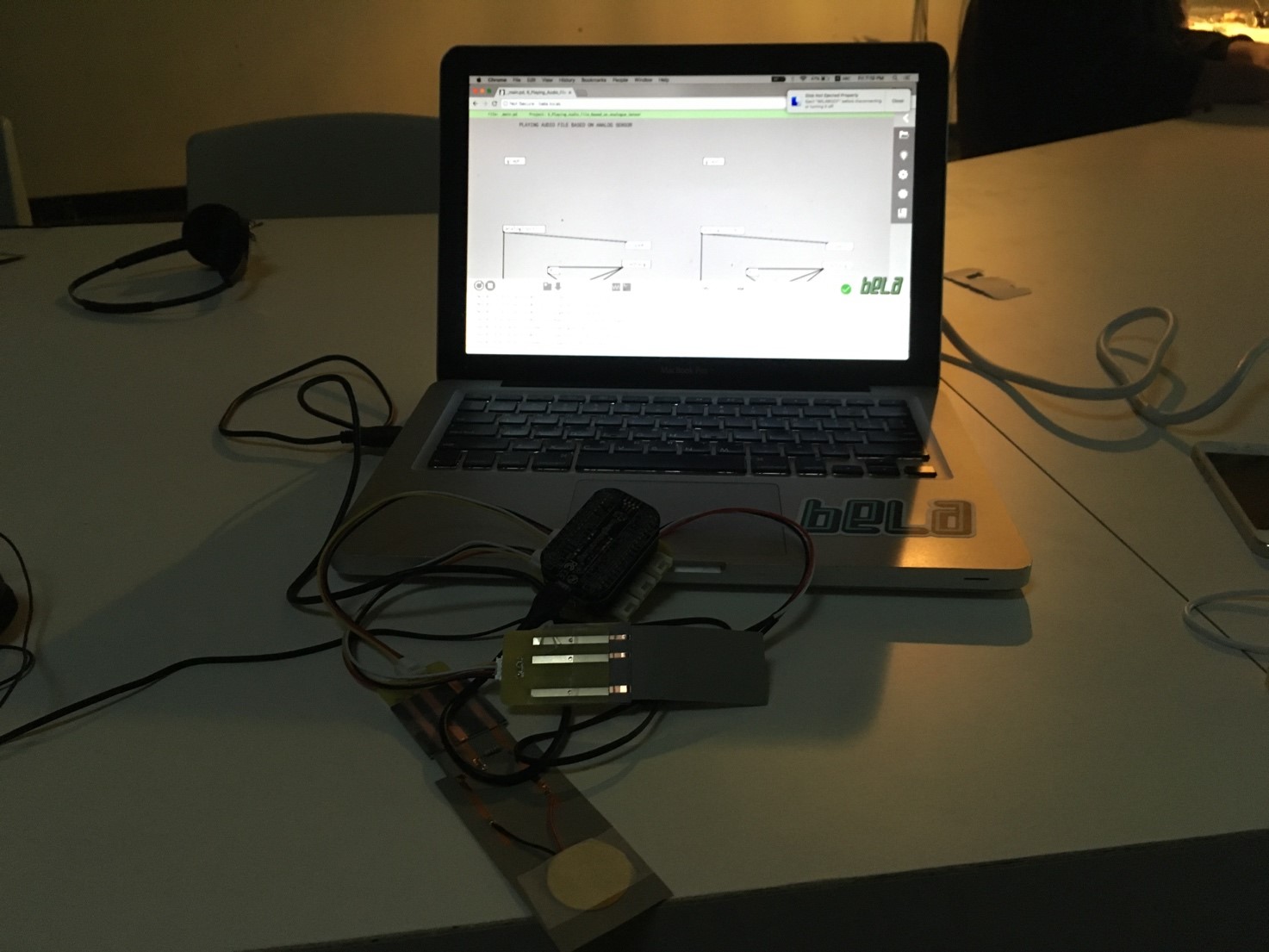
코케타(Coquetta), 이오아나 브레메 모저, 2018
코케타(Coquetta)는 아름다움을 향한 메이크업 의식에 대한 조롱이다. 여성들의 화장품은 ‘핑크 세금(여성 상품이 다른 유사상품보다 비싼 현상)’으로 불려진다. 불협화음으로 변형된 사운드는 욕망으로 가득 찬 화장품에 담긴 독성의 베일을 벗긴다. 납과 비소는 여성들이 매일 사용하는 화장품에 가장 많이 사용되는 화학물질 중 하나이다. 여성들의 몸단장은 단계별로 리드미컬한 화장실 일과처럼 진행된다. 머리 빗질, 보습, 스크럽, 속눈썹 컬링, 아이섀도잉, 파우더 퍼핑, 립스틱 바르기 및 기타 동작들의 소리는 전기-스틸레토힐의 두드림에 따라 작동한다. 신체 모양으로 변형된 장치의 윙윙거리는 소리는 가발 상자, 벨벳, 납땜으로 된 도구들과 함께 쓰레기통에 뒤섞여 있다.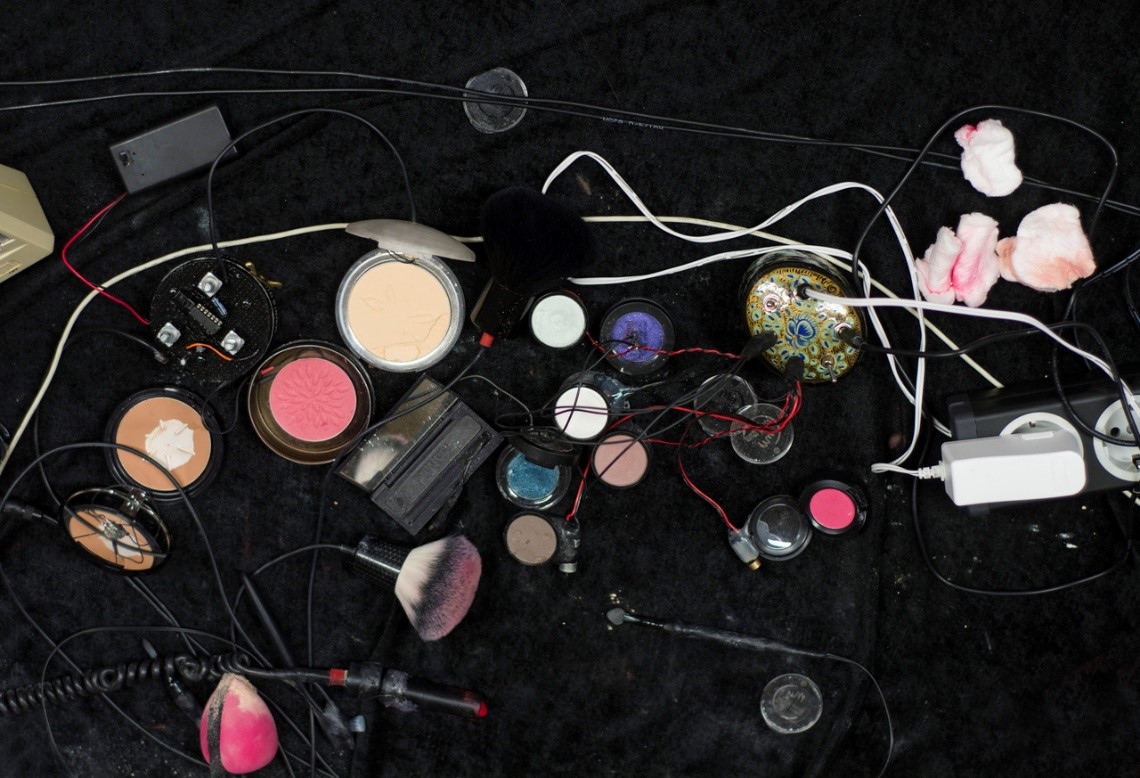
일정: 2018년 11월 15일(목) 오후 7시30분
장소: 채널 1969 (서울 마포구 연희로 35)
참여자: 배인숙, 신원정, 이오아나 브레메 모저
퍼포먼스 소개
소란, 신원정, 2018
8개의 스피커가 큰 동그라미 형태로 배치되어 있다. 8개의 스피커는 한 방향으로 돌면서 움직이는 공간적인 소리가 발생한다. 연주자는 다양한 존재의 목소리들을 모티브로 하는 소리들을 특정 장치로 발생시키고 변주함으로써 소리의 패턴을 만든다. 공연의 말미에는 스마트폰을 가지고 있는 모든 관객들에게 연주에 참여할 수 있는 시간을 가진다. 관객들은 웹플랫폼을 통해서 단순한 인터페이스, 즉 특정 박자에 탭하고 목소리 파일들을 재생시키면서 공동의 목소리를 내는 모의 실험에 초대된다.
소음과 우크렐레, 배인숙, 2018
아날로그 신디사이저의 노이즈 발진기와 필터, 현악기와 타악기의 요소를 추가하여 개조한 우클렐레를 가지고 연주한다.

코케타(Coquetta), 이오아나 브레메 모저, 2018
코케타(Coquetta)는 아름다움을 향한 메이크업 의식에 대한 조롱이다. 여성들의 화장품은 ‘핑크 세금(여성 상품이 다른 유사상품보다 비싼 현상)’으로 불려진다. 불협화음으로 변형된 사운드는 욕망으로 가득 찬 화장품에 담긴 독성의 베일을 벗긴다. 납과 비소는 여성들이 매일 사용하는 화장품에 가장 많이 사용되는 화학물질 중 하나이다. 여성들의 몸단장은 단계별로 리드미컬한 화장실 일과처럼 진행된다. 머리 빗질, 보습, 스크럽, 속눈썹 컬링, 아이섀도잉, 파우더 퍼핑, 립스틱 바르기 및 기타 동작들의 소리는 전기-스틸레토힐의 두드림에 따라 작동한다. 신체 모양으로 변형된 장치의 윙윙거리는 소리는 가발 상자, 벨벳, 납땜으로 된 도구들과 함께 쓰레기통에 뒤섞여 있다.

Performance Night
Dates: 7:30pm Nov 15th (Thu), 2018
Venue: Channel 1969 (35, Yeonhui-ro, Mapo-gu, Seoul)
Artists: Insook Bae, Wonjung Shin, Ioana Vreme Moser
About the Performances
Commotion, Wonjung Shin, 2018
Eight speakers are arranged in a large circle. They produce a spatial sound moving in one direction. The performer creates a pattern of sound by generating and varying the voices of the performing devices. At the end of the performance, all visitors will participate in the performance with smartphones. Visitors are invited through a web platform to simulate a simple interface, tapping on a specific beat, playing a voice file and creating a common voice.
Noise and Ukulele, Insook Bae, 2018
Play a ukulele modified with string and percussion elements with an analog synthesizer's noise oscillator and filter.
Coquetta, Ioana Vreme Moser, 2018
The Coquetta flourishes in a sardonic cosmetic beautifying ritual, amongst dandizectric’ discords and modified 'pink-taxed' items. The desired flawless looks unveil their poisonous essence: lead and arsenic are all-time favourite chemical compounds used in makeup. The step-by-step body preparation occurs as a rhythmical daily toilette routine. Hair combing, moisturizing, scrubbing, eyelash curling, eye-shadowing, powder-puffing, lipstick application, and other sounding manoeuvres get chiselled by the control voltages of the tapping electronic-stilettos. The buzzes of the body appearance altering devices blend inside of the to-go wig boxes and other flirtatious velvet gizmos soldered merely from trash finds.
Dates: 7:30pm Nov 15th (Thu), 2018
Venue: Channel 1969 (35, Yeonhui-ro, Mapo-gu, Seoul)
Artists: Insook Bae, Wonjung Shin, Ioana Vreme Moser
About the Performances
Commotion, Wonjung Shin, 2018
Eight speakers are arranged in a large circle. They produce a spatial sound moving in one direction. The performer creates a pattern of sound by generating and varying the voices of the performing devices. At the end of the performance, all visitors will participate in the performance with smartphones. Visitors are invited through a web platform to simulate a simple interface, tapping on a specific beat, playing a voice file and creating a common voice.
Noise and Ukulele, Insook Bae, 2018
Play a ukulele modified with string and percussion elements with an analog synthesizer's noise oscillator and filter.

Coquetta, Ioana Vreme Moser, 2018
The Coquetta flourishes in a sardonic cosmetic beautifying ritual, amongst dandizectric’ discords and modified 'pink-taxed' items. The desired flawless looks unveil their poisonous essence: lead and arsenic are all-time favourite chemical compounds used in makeup. The step-by-step body preparation occurs as a rhythmical daily toilette routine. Hair combing, moisturizing, scrubbing, eyelash curling, eye-shadowing, powder-puffing, lipstick application, and other sounding manoeuvres get chiselled by the control voltages of the tapping electronic-stilettos. The buzzes of the body appearance altering devices blend inside of the to-go wig boxes and other flirtatious velvet gizmos soldered merely from trash finds.

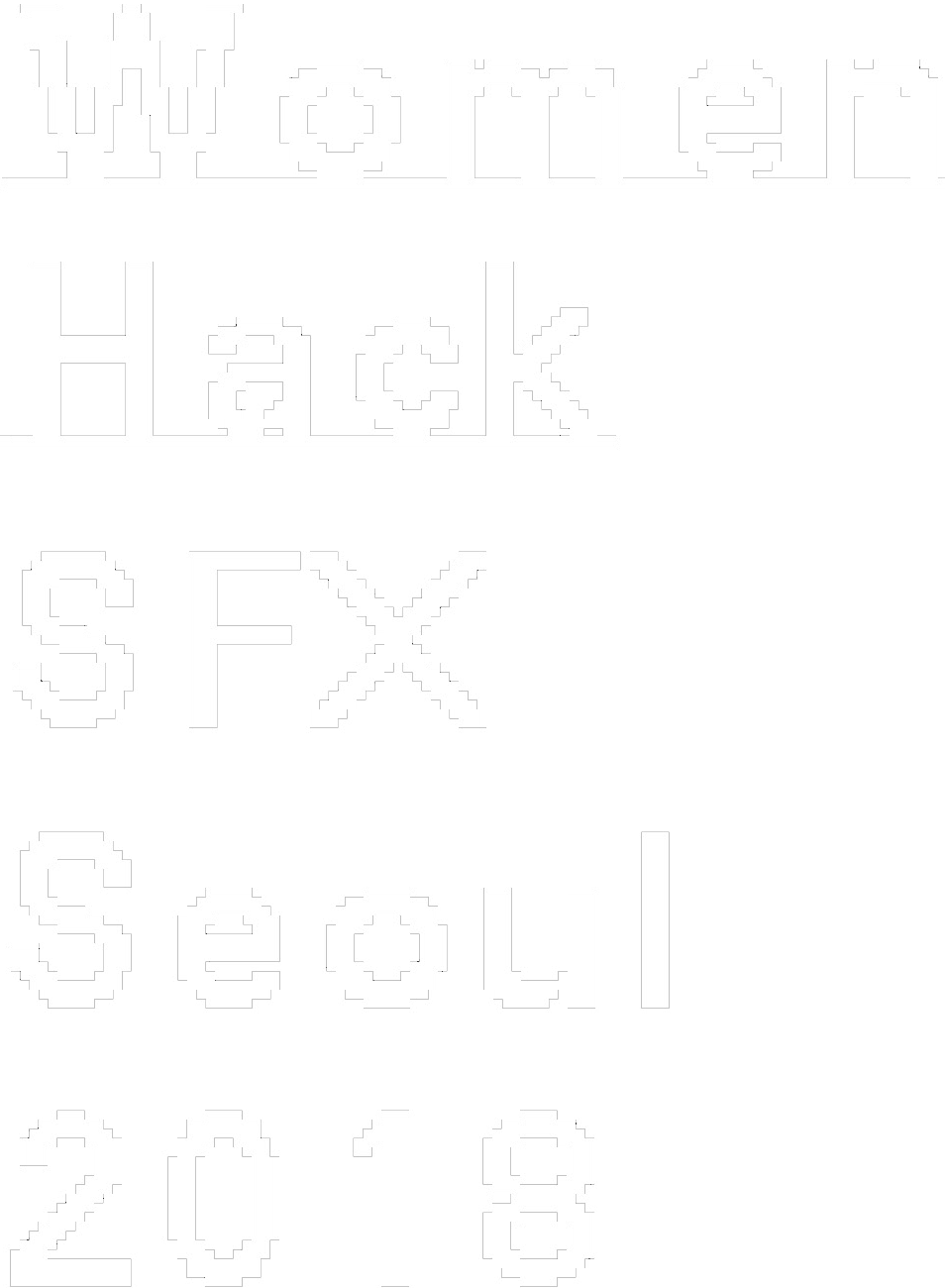
INFO

